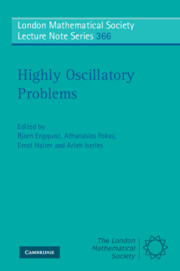Book contents
- Frontmatter
- Contents
- Preface
- 1 Oscillations over long times in numerical Hamiltonian systems
- 2 Highly oscillatory quadrature
- 3 Rapid function approximation by modified Fourier series
- 4 Approximation of high frequency wave propagation problems
- 5 Wavelet-based numerical homogenization
- 6 Plane wave methods for approximating the time harmonic wave equation
- 7 Boundary integral methods in high frequency scattering
- 8 Novel analytical and numerical methods for elliptic boundary value problems
4 - Approximation of high frequency wave propagation problems
Published online by Cambridge University Press: 07 September 2011
- Frontmatter
- Contents
- Preface
- 1 Oscillations over long times in numerical Hamiltonian systems
- 2 Highly oscillatory quadrature
- 3 Rapid function approximation by modified Fourier series
- 4 Approximation of high frequency wave propagation problems
- 5 Wavelet-based numerical homogenization
- 6 Plane wave methods for approximating the time harmonic wave equation
- 7 Boundary integral methods in high frequency scattering
- 8 Novel analytical and numerical methods for elliptic boundary value problems
Summary
Abstract
The numerical approximation of high frequency wave propagation is important in many applications including seismic, acoustic, optical waves and microwaves. For these problems the solution becomes highly oscillatory relative to the overall size of the domain. Direct simulations using the standard wave equations are therefore very expensive, since a large number of grid points is required to resolve the wave oscillations. There are however computationally much less costly models, that are good approximations of many wave equations at high frequencies. In this paper we review such models and related numerical methods that are used for simulations in applications. We focus on the infinite frequency approximation of geometrical optics and the finite frequency corrections given by the geometrical theory of diffraction. We also briefly discuss Gaussian beams.
Introduction
Simulation of high-frequency waves is a problem encountered in a great many engineering and science fields. Currently the interest is driven by new applications in wireless communication (cell phones, Bluetooth, WiFi) and photonics (optical fibers, filters, switches). Simulation is also used increasingly in more classical applications. Some examples in electromagnetism are antenna design, radar signature computation and base station coverage for cell phones. In acoustics simulation is used for noise reduction, underwater communication and medical ultrasonography. Finding the location of an earthquake and oil exploration are some applications of seismic wave simulation in geophysics. Nondestructive testing is another example where both electromagnetic and acoustic waves are simulated.
- Type
- Chapter
- Information
- Highly Oscillatory Problems , pp. 72 - 97Publisher: Cambridge University PressPrint publication year: 2009
- 1
- Cited by



